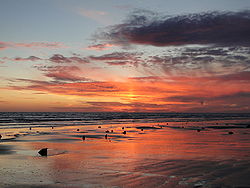Cantre'r Gwaelod
| Cantre'r Gwaelod The Lowland Hundred |
|
|---|---|

Part of an ancient submerged forest at Ynyslas thought to be associated with Cantre'r Gwaelod
|
|
| Welsh mythology location | |
| Genre | Legend |
| Type | Sunken kingdom |
| Notable locations | Caer Wyddno |
| Notable characters | Gwyddno Garanhir, Seithenyn, Elffin ap Gwyddno |
|
|
|
|
Clips from Coast (BBC, 2006) |
Cantre'r Gwaelod, also known as Cantref Gwaelod or Cantref y Gwaelod (English: The Lowland Hundred), is a legendary ancient sunken kingdom said to have occupied a tract of fertile land lying between Ramsey Island and Bardsey Island in what is now Cardigan Bay to the west of Wales. It has been described as a "Welsh Atlantis" and has featured in folklore, literature and song.
Cantre'r Gwaelod was an area of land which, according to legend, was located in an area west of present-day Wales which is now under the waters of Cardigan Bay. Accounts variously suggest the tract of land extended from Bardsey Island to Cardigan or as far south as Ramsey Island. Legends of the land suggest that it may have extended 20 miles west of the present coast.
There are several versions of the myth. The earliest known form of the legend is usually said to appear in the Black Book of Carmarthen, in which the land is referred to as Maes Gwyddno (English: the Plain of Gwyddno). In this version, the land was lost to floods when a well-maiden named Mererid neglected her duties and allowed the well to overflow.
Rachel Bromwich questions this identification, saying that "There is no certainty, however, that in twelfth century tradition Maes Gwyddneu did represent the submerged land in Cardigan Bay." She also links Gwyddno Garanhir with the Hen Ogledd, not Wales.
The popular version known today is thought to have been formed from the 17th century onwards. Cantre'r Gwaelod is described as a low-lying land fortified against the sea by a dyke, Sarn Badrig ("Saint Patrick's causeway"), with a series of sluice gates that were opened at low tide to drain the land.
...
Wikipedia
